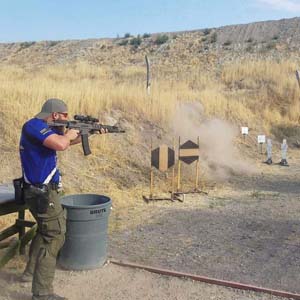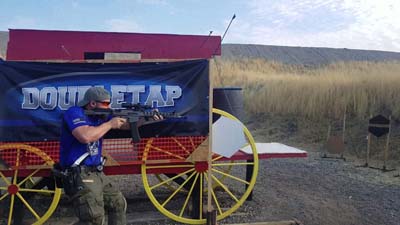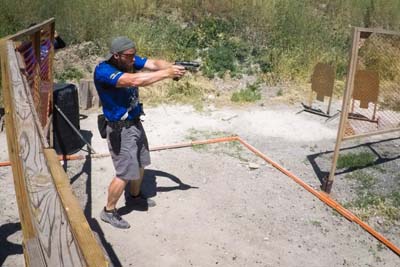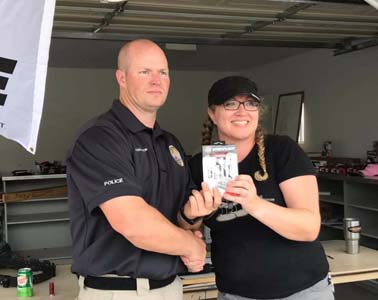COMPETITION SHOOTING AND MENTAL CONDITIONING
By Curtis Robertson
SWAT SGT.
We have all heard it before, “competition will get you killed”. While this is not an article dedicated to dispelling this myth, I am going to talk about how competition can improve your mental game and make you a better tactician. I’m not arguing that the way a stage is run during a shooting match translates into good tactics. It does, however, train your mind to execute a plan, make decisions under pressure, and perform the physical skills of shooting under that pressure. I think we can all agree every tactician or gun fighter should have these skills.
 Tactics
Tactics
Let’s start with a brief discussion on tactics. I will begin by giving my definition of tactics. Implementing tactics is simply choosing the least dangerous option for the given situation. The mission or purpose must be considered first, then the problems you face must be solved to successfully accomplish that mission. Using tactics is a process of making decisions under stress, which ultimately is dynamic problem solving.
Competition is not a replacement for more task-specific training such as Force on Force or Close Quarters Battle (CQB). Competitions are, however, a great way to learn to control emotions, anxiety, and stress while performing complex plans, solving problems, and shooting. The best part is that all of this is done under pressure. Competition, if approached with the correct attitude and mindset, can be one of the best mental and physical training exercises you can participate in.
Using Competition for Mental Training
Now let’s talk more specifically about what shooting competition, specifically the action shooting sports—3-gun, USPSA, IDPA etc.—can do for your mind. Competition trains your brain to perform and stay focused under pressure. Often referred to as “match pressure”, shooters sometimes have their performance impacted by the pressures of time, everyone watching them, and their own desire to win. You can often see the impact these pressures have on shooters as soon as they start a stage. I have seen people who are normally considered great shooters on a stationary firing line fall apart during a stage at a competition. I have seen people freeze and forget where they were supposed to move to engage the next target. I have seen people fumble basic firearms skills, such as reloading the gun, they are normally proficient with on a stationary line. I have seen shooters accidentally run past targets without engaging them. I have seen shooters engage and miss targets altogether because they started trying to shoot faster than their current capabilities. These are the same performance issues that often plague both police and defensive shooters when a stressful event hits. Plain and simple—the more you compete, the more the competitions train you and your brain to think and perform under pressure.
 Pressure itself does not have any effect on performance. What does have an effect, either positive or negative, is the individual’s response to that pressure. As world famous shooter and coach Lanny Bassham said, “Here’s a myth—Pressure causes performance to drop. Pressure does not cause your performance to drop. What I learned about pressure was that when you feel the physical effects of pressure, it’s real. You feel an adrenaline rush and your heart rate and blood pressure go up. I’ve seen shooters shoot extremely high scores with their legs shaking. Pressure doesn’t cause your scores to go up or down, but your attitude does. Your attitude is what’s important.”
Pressure itself does not have any effect on performance. What does have an effect, either positive or negative, is the individual’s response to that pressure. As world famous shooter and coach Lanny Bassham said, “Here’s a myth—Pressure causes performance to drop. Pressure does not cause your performance to drop. What I learned about pressure was that when you feel the physical effects of pressure, it’s real. You feel an adrenaline rush and your heart rate and blood pressure go up. I’ve seen shooters shoot extremely high scores with their legs shaking. Pressure doesn’t cause your scores to go up or down, but your attitude does. Your attitude is what’s important.”
So, how do we develop an attitude that will allow us to use pressure and stress to improve our performance? By training our mind to stay focused on the process of shooting and not get overwhelmed. Some of the fundamentals that should be focused on are: making sure the shooter’s grip on the gun is correct, making sure the sights are aligned and on target, and isolating the trigger finger so there is no unwanted input on the gun when firing.
The problems start when we allow our minds to focus on the possible outcomes—good or bad—instead of the process that will bring success. I’ve seen it more times than I can count, a shooter gets concerned about his performance or ability to shoot a target, and that stress gets into their head. Like a self-fulfilling prophecy, they fail. As shooters learn to control their mind and focus on the proper process of shooting, you see their performance improve, confidence grow, and a newfound poise develop under pressure.
The more we learn about the brain, the more we are coming to understand the mind can, in fact, train the brain. We can recondition, or rewire, how the brain handles things like stress. We can condition the brain to focus on the things that help performance and avoid the things that hinder it. Mental plasticity is the ability for us to change our brain through mental training. Competition is 90 percent mental. The mental skills we can learn and train in a shooting match are some of the most important for real life tactical or combat situations. To learn more about how the mind trains the brain, I suggest reading Sharon Begley’s book Train the Mind, Change the Brain.
 Is Your Mind Free to Think?
Is Your Mind Free to Think?
Subconscious competence with motor skills is one of the greatest tools you can develop for any competition or firearms training. Through the process of myelination, we can build the motor neural pathways and develop physical skills to the point that we no longer need give them conscious thought. This applies to almost all the skills of shooting: draw, grip, a trigger process that does not disturb the sight picture, reloads, and recognizing the sight picture required to get a hit. All these skills can become subconscious through deliberate training and practice.
The human brain cannot multitask. So how do we effectively perform in situations where we must think, make decisions, and perform complex motor tasks? We must make as many of those tasks as we can programmed motor skills. Both competition and tactical situations require decisions be made in very short periods of time, and motor skills of shooting be performed faster and with greater precision than our opponents. Competition—along with Force on Force and other tactical training—is the perfect environment to build and test those skills. If there is a part of your shooting ability that has not been developed to the point of subconscious competence, I can assure you it will show up quickly (and probably in a very humbling way) in a match. I don’t know about you, but I’d much rather learn what areas I’m deficient in during a “game” than in a life-and-death situation.
Not only can we build the skills we need so that no conscious thought is required to perform; we can also increase our speed and effectiveness with these skills. The more we push skill into the cerebellum (the part of the brain believed to store programmed motor skill), the faster and more proficient those skills can become. As Tim Conrad explained in his January 2013 article on muzzle flip, “The conscious signal can take up to 0.3 seconds from recognizing the desired sight picture to moving the trigger finger—too long to capture the opportunity for a perfect shot. However, if the signal is initiated spontaneously in the cerebellum where such procedures are thought to be stored through repetition, the reaction speed is much quicker. Signals are processed by the “deep brain” almost twice as fast as the problem-solving frontal lobes.”
 Are You a Problem Solver?
Are You a Problem Solver?
One of the skills that I find myself practicing the most in a match is quick problem solving. Sometimes the unexpected happens on a stage and you need to alter your plan immediately to try and salvage the stage. This is where you test your subconscious motor skills and see if your mind is trained to think under pressure. Here is a typical example of problem solving in match:
You have a solid plan to engage an array of steel knock-down targets with your shotgun. You have a few targets requiring bird shot. After the bird shot targets, there are three long-range slug targets. Before you start the stage, you load the magazine of your shotgun with the correct amount of slug rounds and bird shot rounds in the order you will need them. During the stage you experience a malfunction with your shotgun. You must clear the malfunction from the shotgun, but in doing so you lose two bird shot rounds that were loaded in the magazine. The malfunction clearance has changed your round count and your original plan is no longer possible. If you lose track of the amount and order of ammo in your gun, you may shoot a slug round at a bird shot target. Shooting a slug round at a target that is too close—a target requiring a bird shot round—is an automatic disqualification for safety reasons. In the middle of this stage, with the pressure of time and the added pressure of possibly making a mistake and being disqualified, you must make a quick decision.
Should you do a standing reload with your shotgun? Will that put the bird shot in the right order? Will that take too much time? Would it be faster for you to engage the slug targets first and then transition from the shotgun to handgun for the close steel targets? What is the fastest option—which is the safest option?
I’ve seen shooters handle this situation by freezing and getting flustered, and others move through the problem so fast and fluid you’d never know they changed their plan. That is valuable training. You just practiced clearing a malfunction under stress, while simultaneously developing and troubleshooting a complex decision under pressure. Sounds like skills that translate into a good gun fighter. It is no coincidence that many of the people I’ve seen so effectively solve these types of problems during a shooting competition are the same people I want going through the door with me to get armed bad guys in real-life situations. I have personally seen these people perform incredibly well in both environments.
 How Confident Are You?
How Confident Are You?
Having confidence in your skills is one of the greatest attributes you can take with you into any high-stress situation. We know that confidence allows us to stay calm in bad situations because it helps us manage stress. One of the key factors that contribute to poor performance in critical incidents is when the person involved believed the situation was outside their capabilities. When the professional has put themselves in difficult and challenging situations, many times they develop the skill to win those situations. They will perform with great skill and composure, and they will believe they can win.
I have made shots quickly and under match pressure that years ago I would have said were not possible. I have developed an understanding of exactly what I am capable of as a shooter. That knowledge and experience brings with it a great deal of confidence in what I can do, and what I should not do in real-world situations. I have tested my limits in safe environments so I know what I can do under pressure. This confidence is not based on hope or a result of the Dunning-Kruger effect—the seemingly pervasive tendency of poor performers to overestimate their abilities relative to other people.
If you want to influence your body, brain, and mind to perform at your best when the stakes are the highest—you need to train. You need deliberate training on firearms fundamentals. You need Force on Force training, scenario-based training, and stress training; you also need competition. You need as much training as you can get. The number of hours we are looking for to become masters of our craft is 10,000 hours. That craft involves firing a gun to defend life, and there are a lot of people counting on you to be able to perform at a very high standard and under the most stressful and pressure-filled conditions. You owe it to yourself, your family, and the public you are protecting to do everything you can to be the master of both your mind and your gun.
 Curtis Robertson has been a Police Officer with the Sandy City Police Department for the past 17 years, working in the patrol division, Metro Gang Unit, as the department training officer and range master. He is currently the sergeant over the narcotics/special investigations unit. He is a SWAT team leader and Sniper team leader. Curtis Has over 16 years experience as a firearms instructor and use of force instructor. Curtis teaches a variety of subjects for the police academy including building search tactics, active gunman, Taser, deadly force decision making, and edged weapon defense. Curtis is also an active competitive shooter.
Curtis Robertson has been a Police Officer with the Sandy City Police Department for the past 17 years, working in the patrol division, Metro Gang Unit, as the department training officer and range master. He is currently the sergeant over the narcotics/special investigations unit. He is a SWAT team leader and Sniper team leader. Curtis Has over 16 years experience as a firearms instructor and use of force instructor. Curtis teaches a variety of subjects for the police academy including building search tactics, active gunman, Taser, deadly force decision making, and edged weapon defense. Curtis is also an active competitive shooter.

